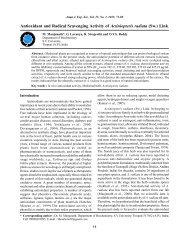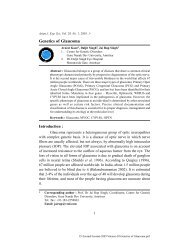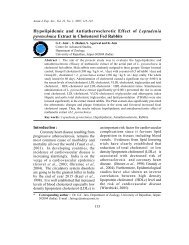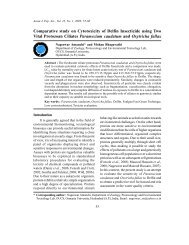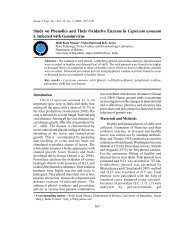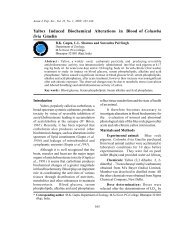Control of Aspergillus parasiticum NCIM 898 infection in ... - Ajes.in
Control of Aspergillus parasiticum NCIM 898 infection in ... - Ajes.in
Control of Aspergillus parasiticum NCIM 898 infection in ... - Ajes.in
Create successful ePaper yourself
Turn your PDF publications into a flip-book with our unique Google optimized e-Paper software.
Key<br />
g%<br />
3<br />
2.5<br />
2<br />
1.5<br />
1<br />
0.5<br />
Method<br />
Number<br />
0<br />
Asian J. Exp. Sci., Vol. 26, No. 1, 2012; 27-38<br />
Figure 1. Biosurfactant extraction us<strong>in</strong>g organic extraction process<br />
K 6 2 A<br />
K 6 2 B<br />
Bacillus subtilis. MTCC 2423<br />
Pseudomonas aerug<strong>in</strong>osa MTCC 2297<br />
1 2 3 4 5 6<br />
Method Number<br />
Reference Organic Solvents Used<br />
1. Cooper et al 1979 Chlor<strong>of</strong>orm- methanol- water (2:1:1)<br />
2. Bryant 1990 Ethyl acetate methanol Silicic acid<br />
(1:2:1)<br />
3. Morikawa 1993 & Barkay et<br />
al 1999<br />
Hexane CH3 (CH2)4CH3<br />
4. Cooper et al 1981 Dichloromethane (CH2Cl2)<br />
5. Macdonald et al 1981 Pentane (C5H12)<br />
6.<br />
Desai & Banat 1997 Chlor<strong>of</strong>orm: Methanol(2:1)<br />
[CHCl -CH OH-H O] to extract surfactant from<br />
3 3 2<br />
Corynebacterium lepus, however, very little<br />
biosurfactant was isolated by this method <strong>in</strong> our study<br />
This could be attributed to the use <strong>of</strong> water <strong>in</strong> which<br />
chlor<strong>of</strong>orm largely rema<strong>in</strong>s immisicible and the actual<br />
ratio <strong>of</strong> Chlor<strong>of</strong>orm-methanol-water used <strong>in</strong> the<br />
experiment. It is reported that the system <strong>of</strong> lipid<br />
extraction could be best designed by ma<strong>in</strong>ta<strong>in</strong><strong>in</strong>g the<br />
chlor<strong>of</strong>orm, methanol and water <strong>in</strong> the comb<strong>in</strong>ed phases<br />
to 8:4:3 (by volume), otherwise selective losses <strong>of</strong> lipid<br />
may occur. In our experimental setup chlor<strong>of</strong>orm,<br />
methanol and water was ma<strong>in</strong>ta<strong>in</strong>ed <strong>in</strong> 10:5:7 (by<br />
volume) as described by Cooper and Goldenberg (1981)<br />
and could be one <strong>of</strong> the reasons <strong>of</strong> not yield<strong>in</strong>g<br />
surfactant for the isolate under study.<br />
Purification<br />
Though the metabolic filtrate used for the harvest<br />
32<br />
<strong>of</strong> biosurfactant was free from the bacterial cells,<br />
presence <strong>of</strong> some cellular debris and prote<strong>in</strong>s <strong>of</strong> the<br />
nutrient broth can form major impurities as they<br />
precipitate with chlor<strong>of</strong>orm -methanol along with the<br />
biosurfactant. Hence purification <strong>of</strong> the biosurfactant<br />
was undertaken with respect to the removal <strong>of</strong> prote<strong>in</strong><br />
from the biosurfactants extracted by organic solvent<br />
method by the potent isolate. Biosurfactant on reprecipitat<strong>in</strong>g<br />
yielded 37.5% prote<strong>in</strong> reduction while,<br />
purification <strong>of</strong> biosurfactant through adsorption<br />
chromatography yielded 87.5% prote<strong>in</strong> reduction<br />
without much loss <strong>of</strong> its lipid content<br />
3. Sporolytic activity <strong>of</strong> S. maltophilia biosurfactant<br />
by Phase contrast microscopy<br />
Fungal spore germ<strong>in</strong>ation marks the resumption<br />
<strong>of</strong> vegetative development lead<strong>in</strong>g to the formation <strong>of</strong> a<br />
new <strong>in</strong>dividual or colony. Germ<strong>in</strong>ation, usually follows



